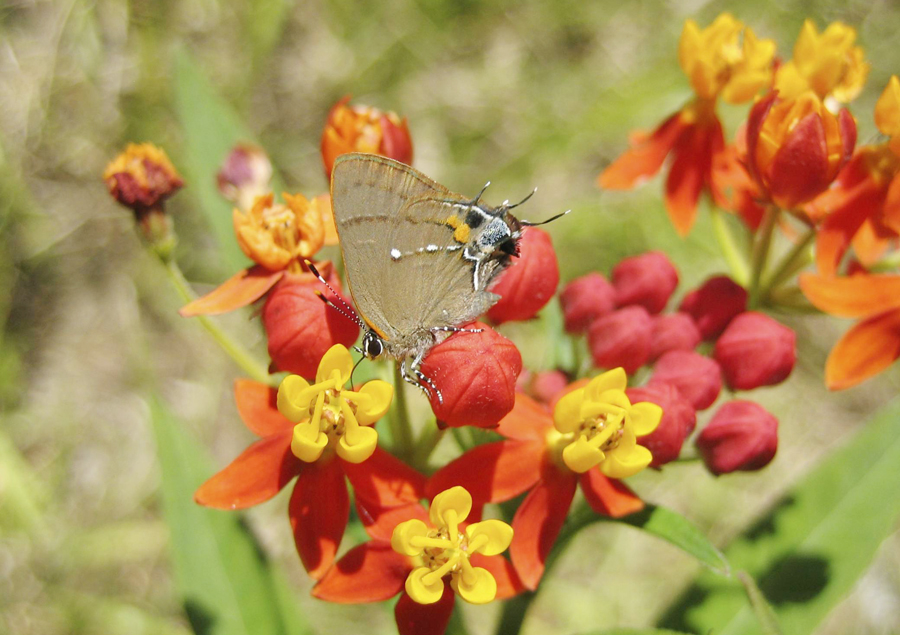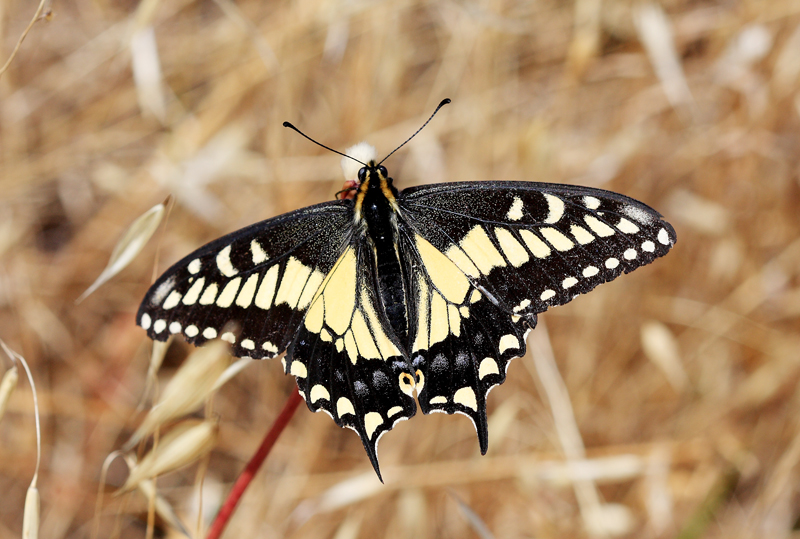Por Chris Grinter, el 8 de septiembre, 2010 Mientras yo trabajo en un puesto más importante, usted puede nombrar a esta mariposa – y la planta debe ser bastante fácil también. Bono extra si se puede adivinar el condado (Estado no va a ser demasiado impresionante) en el que tomé esta foto. Esto fue antes de la DSLR, pero mi viejo destartalado canon de apuntar y disparar se las arregló para conseguir algunas buenas.

Por Chris Grinter, on September 7th, 2010 
A sad story has just made its way up from Belize – los las American Crocodile Education Sanctuary has burned to the ground. At first glance this was merely an unfortunate report about a research and conservation facility that had been lost in a tragic fire. That, sin embargo, is not the entire story. It turns out that a mob of indigenous Mayans flew into a rage and torched the facility. Why? Because a psychic told them the owners had murdered children and fed them to their crocodiles!
It was like something out of a Frankenstein movie,” Cherie Rose said Tuesday. “If we’d been home, they would have killed us. They said they were going to chop us up and feed us to the crocodiles.”
National police confirm that the indigenous Maya villagers were acting on the advice of a psychic who said the Roses had something to do with the August 7 disappearance of 9-year-old Benjamin Rash and his 11-year-old sister Onelia.
The question often comes up – “what harm is it really?” – in regards to this sort of anti-scientifc woo. Most of the time, there really isn’t any damage done, except to the pocketbook. Sino, every once in a while, something tragic happens and it all could easily have been avoided with even the tiniest bit of rational thought or discretion. The psychic in town was far and beyond reckless by blaming these gringos – and she should suffer the consequences for her actions. She deliberately blamed two innocent people for the death of local children, which quickly resulted in a severe loss of personal property. Afortunadamente, Cherie and Vince Rose were both away at the time rescuing a crocodile – they may have not escaped the angry mob had they been at home. Examples of this always make me sad, but reignite my passion for debunking these thieves and criminals.
I suggest visiting the ACES website and blog and either donate or write a note of support. If I weren’t a broke scientist myself, I’d offer more assistance for their efforts to rebuild. Ahora – who will help educate those villagers before this happens again?!
Por Chris Grinter, on September 6th, 2010 Para los lectores habituales de mi blog, es posible que ya conozcan mi postura sobre el monarca., pero ponte al día aquí Si tu quisieras. Ayer me encontré Este artículo en los tiempos de LA – sobre las colonias de hibernación de las monarcas en Pacific Grove, California. Aquí afuera, al oeste de la divisoria continental, hay bastantes monarcas que migran a la costa de California y Baja del Norte en lugar de viajar al centro de México. No todas las monarcas de California se quedan en el estado, Pero hay docenas cientos de dormideros conocidos (.pdf) arriba y abajo de nuestra costa pacífica.
Pacific Grove tiene una de las localidades más conocidas y ha construido la economía local en torno a sus migrantes estacionales. (sin embargo nadie esta deportando a estos mexicanos). En breve, el gobierno de la ciudad contrató a un arbolista para reducir el crecimiento peligroso de eucaliptos. ¿Por qué era eso necesario?? De nuevo en 2004 una rama de un pino nativo enfermo había caído y había matado a una mujer de 85 años mientras paseaba con sus nietos. A raíz del acuerdo de un millón de dólares pagado a la familia del difunto, la ciudad decidió reducir preventivamente el crecimiento de árboles viejos.. Pero ahora todo el mundo está corriendo gritando falta, los árboles fueron podados también mucho. Sí, las preciosas casas de los monarcas fueron perturbadas y ha irritado a la gente del pueblo en una furia. ¿Qué pasa si el monarca no regreso?
No te preocupes, el cineasta local Bob Pacelli tiene una solución. Simplemente dispersemos tantos eucaliptos como podamos encontrar en la arboleda para atraer más mariposas..
En desesperación, A Pacelli se le ocurrió un plan.: Encuentre árboles en caja, preferiblemente eucaliptos de goma azul, alrededor 20 pies de altura y colóquelos en lugares estratégicos para ayudar a proteger a las monarcas entrantes. Pero la ciudad ha tardado en responder., Pacelli dijo. un oficial, Pacelli dijo, lo acusó injustamente de pisar una mariposa, una violación del código de la ciudad. No se presentaron cargos.
Para los que están atentos, sí, el ayuntamiento de Pacific Grove tiene una ley en los libros que impone una multa de $1,000 sobre cualquiera que moleste a una mariposa. Cosas buenas que los monarcas no se posan en las iglesias católicas.
Continue reading Monarch Madness
Por Chris Grinter, on August 27th, 2010 This genius of the press is extra special, not for its difficulty, but for its redundancy. I found the same story carried on two separate sources, with different images – and both equally incorrect! I can imagine that it won’t take long for someone to point out exactly what’s wrong with these stories (hint, hay 2 things).
Here is the first from the Mirror.co.uk “Giant rare moth found in Devon”.

And the second from the Daily Mail online ” Rare Luna moth found on Devon…”

Por Chris Grinter, el 24 de agosto, 2010 And while I catch up you can watch some creepy Isabella Rossellini re-enact the mating strategies of a bedbug. You should also read, if you haven’t caught it already, los las excellent bedbug article written by the distinguished (and my former professor) May Berenbaum.
[youtube=http://www.youtube.com/watch?v=MakIB_IJnu0&feature=search]
Por Chris Grinter, on August 14th, 2010 Tonight, if you’re in San Francisco, you should make your way to Showdogs bar (near the SoMa) for skeptics in the pub with the honorable James Randi! I’ll be in attendance, along with a few fellow entomologist friends. Try this facebook link – but if that fails, the event starts at 9pm.
If you’re not in SF, enjoy some Randi videos instead!
[youtube=http://www.youtube.com/watch?v=M9w7jHYriFo]
Por Chris Grinter, el 10 de agosto, 2010 
En la foto, un negro-blanco veteado (Aporía crataegi ssp), and it is currently being returned to the Korean Institute of Biological Resources. Préstamos consiguen devueltos, como debe ser, todos los días – e incluso puede número en los miles de especímenes. I myself have a few hundred moths out on loan from a handful of museums that are pending research. As soon as I finish my work (or request an extension), the specimens are promptly returned accompanying my paper. Unfortunately it is not a rare occurrence where loans have gone out, and remained out without permission, for decades. At least in one case to my knowledge (names and institutions redacted) the loaned specimens were out so long they created a small international incident. Foreign ambassadors had to formally request the specimens, which had to be presented in person by our ambassador to their country.
This butterfly, sin embargo, I don’t believe was part of a loan. So why is it going back to Korea?
Continue reading A Disturbing New Trend?
Por Chris Grinter, on August 9th, 2010 This one is just también easy. The billboard is on I-35 south of Burleson, Texas.

I don’t know the true provenance of this image, but it came my way from Omar Bocanegra via Mike Quinn on the Texas Lepidoptera list-serv.
Por Chris Grinter, on August 8th, 2010 
I stumbled upon (not on stumbleupon) these colored SEM images on the Telegraph webpage today. I especially love this image of a Calliphoridae larva (Protophormia sp.) that seems more out of a C-rated science fiction movie than nature. It reminds me of both a freakish Star Wars character and a Muppet at the same time. The abrupt departure from standard mammalian body architecture makes insects prime candidates for other-worldly aliens. Insects must have been used as a guide for movies like District 9, Starship Troopers, Alien, Galaxy Quest… just to name a few recent ones. I am sure that other, more well-accredited, sci-fi geeks out there can think of even better examples. Along the same lines I recall these images I snapped of a Cerambycidae beetle below – Moneilema gigas. This was in the earliest days of my new camera so I can’t look back on them as perfect shots.
Continue reading Muppet Monsters
Por Chris Grinter, el 6 de agosto, 2010 
Aquí hay un macho en la cima de la colina mariposa celíaca, o cola de golondrina de anís. Esta mariposa está muy extendida en los estados del Pacífico occidental y probablemente sea mucho más común de lo que alguna vez fue.. Después de la introducción del hinojo (Foeniculum vulgare), y posterior escape de la horticultura, la cola de golondrina de anís se afianzó como una mariposa común de California. Quizá antes de que esta planta se apoderara de nuestros caminos, la zelicaon puede haber estado restringido a las estribaciones de la Sierra, ahora puedes encontrarlo en los jardines de todo California. Aunque, las cosas parecen estar invirtiéndose en el sur de California, donde esta mariposa está desapareciendo de las áreas urbanas. La reciente introducción de la polilla gitana en las áreas de Ventura/LA ha iniciado regímenes de rociado de insecticidas – sin mencionar la aparición de un parásito Tachinidae invasivo que ama a los leps más grandes. En la costa este, esta mosca parásita y la fuerte fumigación han extirpado a la polilla imperial. (águilas imperiales) de gran parte de su rango, dejándolo en peligro de extinción en la mayor parte de Nueva Inglaterra.
Continue reading Butterfly Porn
|
Escepticismo
|








